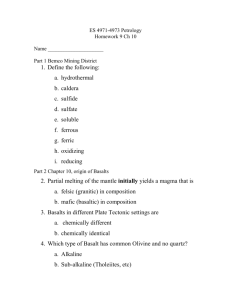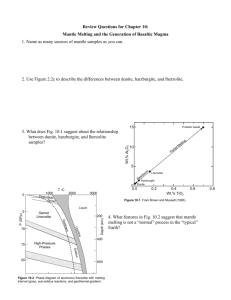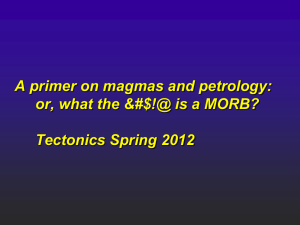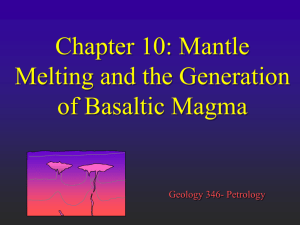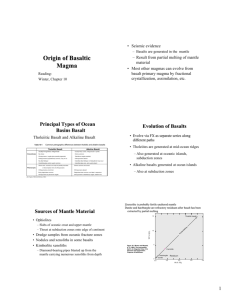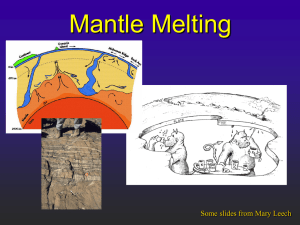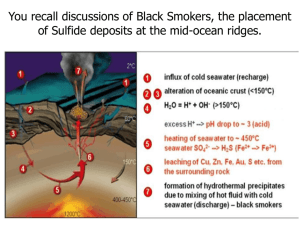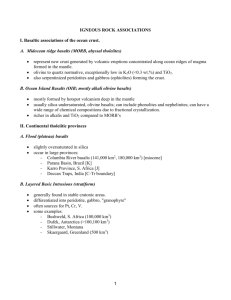Origin of Basaltic Magma
advertisement
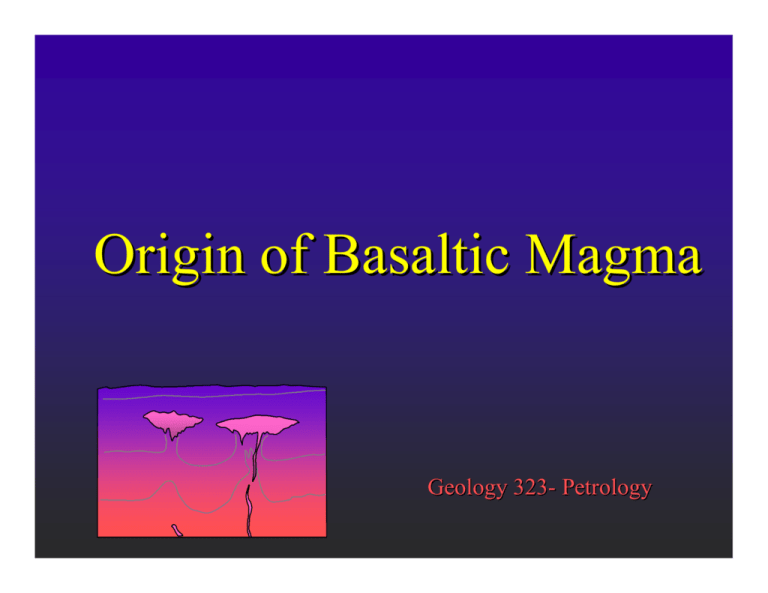
Origin of Basaltic Magma Geology 323- Petrology 2 principal types of basalt in the ocean basins Tholeiitic Basalt and Alkaline Basalt Table 10-1 Common petrographic differences between tholeiitic and alkaline basalts Tholeiitic Basalt Groundmass Usually fine-grained, intergranular Usually fairly coarse, intergranular to ophitic No olivine Olivine common Clinopyroxene = augite Titaniferous augite Orthopyroxene (hypersthene) common Orthopyroxene absent No alkali feldspar Interstitial alkali feldspar or feldspathoid may occur Interstitial glass and/or quartz common Interstitial glass rare, and quartz absent Olivine rare, unzoned, and may be partially resorbed Phenocrysts Alkaline Basalt Olivine common and zoned or show reaction rims of orthopyroxene Orthopyroxene uncommon Orthopyroxene absent Early plagioclase common Plagioclase less common, and later in sequence Clinopyroxene is pale brown augite Clinopyroxene is titaniferous augite, reddish rims after Hughes (1982) and McBirney (1993). Each is chemically distinct Evolve by fractional crystallization as separate series along different paths O O Tholeiites are generated at mid-ocean ridges ) Also generated at oceanic islands, subduction zones Alkaline basalts generated at ocean islands ) Also at subduction zones Sources of mantle material O Ophiolites Slabs of oceanic crust and upper mantle ) Thrust at subduction zones onto edge of continent ) O O O Dredge samples from oceanic fracture zones Nodules and xenoliths in some basalts Kimberlite xenoliths ) Diamond-bearing pipes blasted up from the mantle carrying numerous xenoliths from depth Lherzolite: A type of peridotite with Olivine > Opx + Cpx Olivine Dunite Peridotites lit hr We Lherzolite e Ha rzb urg it e 90 40 Pyroxenites Olivine Websterite Orthopyroxenite 10 10 Orthopyroxene Websterite Clinopyroxenite Figure 2-2 C After IUGS Clinopyroxene Lherzolite is probably fertile unaltered mantle Dunite and harzburgite are refractory residuum after basalt has been extracted by partial melting Tholeiitic basalt Wt.% Al2O3 15 Figure 1010-1 Brown and Mussett, Mussett, A. E. (1993), The Inaccessible Earth: An Integrated View of Its Structure and Composition. Chapman & Hall/Kluwer Hall/Kluwer.. 10 tia r Pa g tin l e lM 5 Lherzolite Harzburgite Dunite 0 0.0 0.2 Residuum 0.4 Wt.% TiO2 0.6 0.8 Phase diagram for lherzolite with Al-rich phase: Al-phase = O Plagioclase ) O Spinel ) O 50-80 km Garnet ) O shallow (< 50 km) 80-400 km Si → 6-fold coordination ) > 400 km Figure 1010-2 Phase diagram of aluminous lherzolite with melting interval (gray), (gray), subsub-solidus reactions, and geothermal gradient. After Wyllie, P. J. (1981). Geol. Rundsch. Rundsch. 70, 128128-153. How does the mantle melt? 1) Increase the temperature Figure 1010-3. Melting by raising the temperature. 2) Lower the pressure ) Adiabatic rise of mantle with no conductive heat loss ) Decompression melting could melt at least 30% Figure 1010-4. Melting by (adiabatic) pressure reduction. Melting begins when the adiabat crosses the solidus and traverses the shaded melting interval. Dashed lines represent approximate % melting. 3) Add volatiles (especially H2O) Figure 1010-4. Dry peridotite solidus compared to several experiments on H2O-saturated peridotites. Melts can be created under realistic circumstances O O O Plates separate and mantle rises at mid-ocean ridges ) Adibatic rise → decompression melting Hot spots → localized plumes of melt Addition of fluids may cause low velocity layer – LVL – in the asthenosphere ) Also important in subduction zones and other settings Generation of tholeiitic and alkaline basalts 1) Chemically hemica uniform mantle Variables: Temperature Figure 1010-2 Phase diagram of aluminous lherzolite with melting interval (gray), subsubsolidus reactions, and geothermal gradient. After Wyllie, P. J. (1981). Geol. Rundsch. Rundsch. 70, 128128-153. Variables: Pressure Change in first melt composition (eutectic) with increasing P Figure 1010-8 Change in the eutectic (first melt) composition with increasing pressure from 1 to 3 GPa projected onto the base of the basalt tetrahedron. After Kushiro (1968), J. Geophys. Geophys. Res., Res., 73, 619619-634. Initial Conclusions: O Tholeiites favored by shallower melting 25% melting at <30 km → tholeiite 1 GPa = 35 km depth O Tholeiites favored by greater % partial melting 20 % melting at 60 km → alkaline basalt 30 % melting at 60 km → tholeiite Crystal fractionation of magmas as they rise from depth O O O O Tholeiite → alkaline basalt by fractional crystallization at med to high P (~1.5 GPa) Not at low P (<1.5 GPa) At high P (>2 GPa) Low-P fractional crystallization → high-Al basalt Figure 1010-10 Schematic representation of the fractional crystallization scheme of Green and Ringwood (1967) and Green (1969). After Wyllie (1971). The Dynamic Earth: Textbook in Geosciences. Geosciences. John Wiley & Sons. Models for Basalt Genesis 1. Composition of primary basalts controlled by • depth • % of partial melting • type of volatiles (i.e., H2O-rich or CO2-rich) 2. Compositions of basalt at surface controlled by fractional xstallization during ascent 3. Tholeiites = shallow melting, greater % partial melting, ol fractionation, H2O-rich volatiles 4. Alkaline basalts = deeper sources, small % partial melting, CO2-rich volatiles 5. Tholeiites also form by ol fractionation during rise of ol-rich basalts (picrites) 6. Alkaline basalts by deep-seated fractionation of Alrich silicate phases (e.g., opx, cpx) Primary magmas O Formed at depth and not subsequently modified by fractional crystallization or assimilation O Criteria Highest Mg# (100Mg/(Mg+Fe)) → parental magma Experimental results of lherzolite melts Mg# = 66-75 V Cr > 1000 ppm V Ni > 400-500 ppm V Multiply saturated with different mineral phases V Multiple saturation with several mineral phases O At Low P Ol then Plag then Cpx as magma cools Figure 1010-12 Anhydrous PP-T phase relationships for a midmid-ocean ridge basalt suspected of being a primary magma. After Fujii and Kushiro (1977). Carnegie Inst. Wash. Yearb. Yearb., 76, 461461-465. Multiple saturation with several mineral phases At High P ) Cpx then Plag then Ol Figure 1010-12 Anhydrous PP-T phase relationships for a midmid-ocean ridge basalt suspected of being a primary magma. After Fujii and Kushiro (1977). Carnegie Inst. Wash. Yearb. Yearb., 76, 461461-465. Multiple saturation with several mineral phases At 25 km get all at once ) = Multiple saturation ) Suggests that 25 km is the depth of last equilibrium with the mantle Summary O A chemically homogeneous mantle can yield a variety of basalt types O Alkaline basalts are favored over tholeiites by deeper melting and by low % PM O Fractionation at moderate to high depths can also create alkaline basalts from tholeiites Chemically Heterogeneous Mantle Model Mantle Xenoliths – fragment of the mantle incorporated into a magma Fertile xenoliths – • higher in Ca, Al, Ti, Na and K •lower in Mg/(Mg+Fe) and Cr/(Cr+Al) Depleted xenoliths – opposite of above Trace element patterns – REE (rare earth elements) are trace elements used to understand magma genesis REE patterns for basalts show the following: MORB (mid-ocean ridge basalts) – most common magma; derived from depleted mantle from earlier extraction of oceanic and continental crust OIB (oceanic island basalts) – appear to have been derived from non-depleted (fertile) mantle sources Conclusion: mantle not homogeneous; contains at least two principal reservoirs, depleted and fertile REE data for oceanic basalt – different for OIB and MORB increasing incompatibility Figure 1010-13a. REE diagram for a typical alkaline ocean island basalt (OIB) and tholeiitic midmid-ocean ridge basalt (MORB). From Winter (2001) An Introduction to Igneous and Metamorphic Petrology. Prentice Hall. Data from Sun and McDonough (1989). LREE depleted or unfractionated LREE enriched REE data for ultramafic xenoliths from spinel and garnet lherzolite LREE depleted or unfractionated Figure 1010-14 ChondriteChondrite-normalized REE diagrams for spinel (a) and garnet (b) lherzolites. After Basaltic Volcanism Study Project (1981). Lunar and Planetary Institute. LREE enriched Spider diagram for OIB and MORB increasing incompatibility Figure 1010-13b. Spider diagram for a typical alkaline ocean island basalt (OIB) and tholeiitic midmid-ocean ridge basalt (MORB). From Winter (2001) An Introduction to Igneous and Metamorphic Petrology. Prentice Hall. Data from Sun and McDonough (1989). Sr Isotopic Evidence 87Rb decays to 87Sr λ = 1.42 x 10-11 yrs Rb (parent) concentrated in enriched reservoir (continental crust) – considered incompatible Enriched reservoir develops more 87Sr (daughter) over time Depleted reservoir (mantle - less Rb) - develops less 87Sr over time Review of Sr isotopes Figure 99-13. After Wilson (1989). Igneous Petrogenesis. Unwin Hyman/Kluwer Hyman/Kluwer.. Review of Nd isotopes Sm → 143Nd λ = 6.54 x 10-13 yrs O 147 Nd (daughter) → enriched reservoir (continental crust) > Sm (parent) Enriched reservoir develops less 143Nd over time O Depleted reservoir (mantle) (higher Sm/Nd) develops higher 143Nd/144Nd over time REE diagram Nd Sm . Nd Isotope Evolution Figure 99-15. After Wilson (1989). Igneous Petrogenesis. Petrogenesis. Unwin Hyman/Kluwer Hyman/Kluwer Nd and Sr isotopes of Ocean Basalts “Mantle Array” Figure 1010-15 (a) Initial 143Nd/144Nd vs. 87Sr/86Sr for oceanic basalts. basalts. From Wilson (1989). Igneous Petrogenesis. Unwin Hyman/Kluwer Hyman/Kluwer.. Data from Zindler et al. al. (1982) and Menzies (1983). Whole Mantle Convection Model (1975) Figure 1010-16a After Basaltic Volcanism Study Project (1981). Lunar and Planetary Institute. Newer mantle convection model Upper depleted mantle = MORB source ) Lower undepleted and enriched OIB source ) Figure 1010-16b After Basaltic Volcanism Study Project (1981). Lunar and Planetary Institute.
